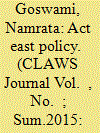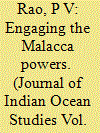| Srl | Item |
| 1 |
ID:
139172


|
|
|
|
|
| Summary/Abstract |
For many years now, since 1992, when it laid its seed and slowly gathered momentum in policy circles, the “Look East” policy has been oft repeated in New Delhi’s strategic and policy circles as one of India’s foremost long-term policy visions to open up its economy for investment and trade with Southeast Asia. Increasingly now, the reference has changed from “Looking East” to “Acting East” by which one would expect that the policy is in its implementation phase. In augmenting the “Act East” policy, the northeast of India emerges, by the criterion of geography, as the region which will act as the ‘strategic catalyst’ or ‘game changer’ in accomplishing the vision that the policy aspires to embolden. Situated between China, Bhutan, Bangladesh, and Myanmar and with an international border stretching up to 4, 500 km, the region has held the promise of acting as a bridge between India and Southeast Asia for years. Its history vindicates such a role as its people have traded and travelled across the Southeast Asian region and Yunnan for years through the ancient Silk Road, trading in Himalayan salt, spices, handicrafts, food items, silk and other goods. This region witnessed migration of people from Southeast Asia and Yunnan to Assam and its surrounding hills, the most prominent being the Ahoms tracing their roots to the Tai race in Yunnan and Thailand. The Ahoms led by Sukapha arrived in Assam in
1228 A.D. and ruled over this region for 600 years. It is significant to note that the Ahoms under Lachit Borphukan successfully prevented Mughal expansion into Assam by defeating the Mughal Army in the much revered Battle of Saraighat of 1671.1
|
|
|
|
|
|
|
|
|
|
|
|
|
|
|
|
| 2 |
ID:
111706


|
|
|
| 3 |
ID:
116676


|
|
|
|
|
| Publication |
2012.
|
| Summary/Abstract |
Globalization has led to new health challenges for the twenty-first century. These new health challenges have transnational implications and involve a large range of actors and stakeholders. National governments no longer hold the sole responsibility for the health of their people. These changes in health trends have led to the rise of global health governance as a theoretical notion for health policy making. The Southeast Asian region is particularly prone to public health threats such as emerging infectious diseases and faces future health challenges including those of noncommunicable diseases. This study looks at the potential of the Association of Southeast Asian Nations (ASEAN) as a regional organization to lead a regional dynamic for health cooperation in order to overcome these challenges. Through a comparative study with the regional mechanisms of the European Union (EU) for health cooperation, we look at how ASEAN could maximize its potential as a global health actor. Our study is based on primary research and semistructured field interviews. To illustrate our arguments, we refer to the extent of regional cooperation for health in ASEAN and the EU for (re)emerging infectious disease control and for tobacco control. We argue that regional institutions and a network of civil society organizations are crucial in relaying global initiatives, and ensuring the effective implementation of global guidelines at the national level. ASEAN's role as a regional body for health governance will depend both on greater horizontal and vertical integration through enhanced regional mechanisms and a wider matrix of cooperation.
|
|
|
|
|
|
|
|
|
|
|
|
|
|
|
|